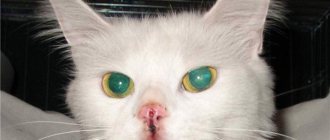Wounds, scabs and sores on a pet’s body are just one of the symptoms of the underlying disease. Only a qualified veterinarian can identify the true cause of the appearance of wounds on an animal’s skin, especially in the neck area.
The cat owner can only complement the clinical picture by telling all the signs observed in the pet before the appearance of wounds and after the appearance of sores on the neck. Timely contact with a specialist allows you to prevent serious complications and successfully cure the pathological process.
The main causes of neck pain
Sores in a cat’s neck occur as a result of many reasons, closely intertwined with internal and external factors. A symptom such as a wound or crust on the neck is evidence of the development of a pathology, and if combined with itching, frequent scratching and restlessness of the animal, it requires immediate medical attention.
Wounds can look completely different, but in most cases they are covered with specific crusts - scabs. The main reasons for the development of wounds on the skin are:
- Increased sensitivity to the bites of blood-sucking parasites. Flea dermatitis is one of the most common causes diagnosed in veterinary medicine and is the cause of a cat scratching its neck until it bleeds. Feeding on the cat's blood, the parasites bite through the skin and inject a specific substance that contains up to 14 protein allergens that cause a specific reaction in the body. Sores are located with flea dermatitis on the head, neck and paws, as well as at the root of the tail.
- Food allergy. A specific response of the body to the introduction of foreign protein components along with food and other foods provokes the appearance of sores on the skin in cats as a result of scratching. The cat scratches its neck until it hurts due to severe itching that occurs against the background of an allergic reaction. In those places where the animal itches and scratches with its claws, areas of alopecia form. In some cases, vomiting may occur due to allergies. If a food allergy is diagnosed in a cat, it is necessary to change the cat’s diet and prescribe further adequate treatment.
- Dermatitis. The contact form of dermatitis develops in pets due to the cat's close contact with certain irritating factors - chemicals, plants and medications. In this case, itching in a cat occurs out of season and is characterized by the appearance of sores, scratching, and hair loss. The areas of the ears, forelimbs, and neck are most often affected. The basis of therapy is the exclusion of the irritating factor, as well as the provision of symptomatic treatment to eliminate itching and speedy healing of wounds.
- Scabies mite. Scabies, caused in cats by a dangerous mite, leads to severe itching and the formation of sores. The mite lives under the skin, infecting various areas of the skin. If the animal is not treated in a timely manner, it can cause nervous exhaustion in the cat due to constant itching.
- Lichen. A fungal infection of the skin called ringworm is a native cat disease. Affected areas of the skin by pathogenic fungal microorganisms can cause not only itching and baldness, but also the formation of sores.
- Acne. Cat acne is the appearance of clogged pores called comedones in the chin area. Cat acne causes the development of inflammatory processes and subsequently the formation of scabs on the skin.
- Bacterial lesions. Pathogenic bacterial microflora, causing irritation on the skin, leads to the development of purulent wounds. Pyoderma mainly affects animals with weak immune defenses. Therefore, the task of the animal owner is to strengthen the animal’s body in every possible way, carefully selecting the diet and not getting carried away with self-medication.
Types of skin cancer
The most common skin cancers are basal cell (about 80%) and squamous cell (about 4%). In third place is skin melanoma (about 4%). Skin melanoma has a number of specific features of the course of the disease and treatment, and therefore is considered separately. Bowen's disease - superficial squamous cell carcinoma and keratoacanthoma, which is classified as a highly differentiated form of squamous cell carcinoma, should also be highlighted separately.
Rarer types of skin cancer include Merkel carcinoma, cancer of the sweat or sebaceous glands, Paget's disease, Kaposi's sarcoma, T-cell lymphoma of the skin (mycosis fungoides).
How to detect a tumor at an early stage?
To detect early forms of skin cancer, it is recommended that everyone undergo a head-to-toe skin examination once a month.
The technique for self-examination of the skin can be found here (.docx, 104 Kb).
To increase the effectiveness of this procedure at the Rassvet clinic, we will help you conduct a skin examination. The doctor will perform a full body examination to ensure that any spots, freckles or moles present are normal and do not require treatment. If necessary, the doctor will perform a dermatoscopy and check the skin with a special instrument under magnification, which allows us to identify tumor processes invisible to the naked eye. If there are indications, a treatment program will be drawn up for you or a period of observation will be determined.
After the first few attempts, the self-test should take no more than 10 minutes - a small investment in what could be a life-saving procedure!
Important: Skin cancer is easy to treat in its early stages. The larger the tumor, the more extensive the treatment. Although skin cancers rarely spread to vital organs, they can cause severe deformities and sometimes result in nerve or muscle injuries. Some rare, aggressive forms can be fatal if prompt action is not taken early.
How to conduct a self-examination and what to pay attention to?
Below we list the symptoms that are typical for skin cancer. Most often, two or more symptoms are present with a malignant tumor.
- An unhealed wound. An open wound that bleeds, oozes, or crusts over and does not heal for more than 2 weeks despite treatment. A wound that heals and then bleeds again. A wound that won't heal is a very common sign of skin cancer.
- The presence of a long-lasting reddish spot or local irritation , which is more common on the face, chest, shoulders, arms or legs. Sometimes the spot becomes crusty. The spot may also itch or hurt, or be present without discomfort.
- The appearance of a tubercle or node. The color is often pearlescent or light, often with a pink or red tint. The lump can also be brown or black in color, especially in dark-haired people, and it can be confused with a regular nevus (mole).
- A pink formation with a slightly raised, undermined border and a depression in the center. As it grows slowly, tiny blood vessels may appear on the surface.
- The scar-like area is white, yellow, or waxy and often has poorly defined boundaries. The skin itself looks shiny and elastic. This warning sign may indicate the presence of infiltrative growth in the surrounding tissue when the true size of the tumor is larger than the visible margins.
If you notice any of these signs or other alarming changes in your skin, be sure to consult a doctor!
Important: Remember that sometimes early skin cancer resembles non-cancerous skin conditions such as psoriasis or eczema. Only a doctor with special knowledge of skin diseases and the necessary equipment can make the correct diagnosis.
Diagnosis of diseases
Determining the exact cause that triggered the formation of scabs on a cat’s neck can only be determined by a qualified veterinarian. First of all, the doctor collects an anamnesis, determining when the first characteristic signs of lesions appeared.
Perhaps the appearance of itching and sores is seasonal, or the animal is on medication.
Next, laboratory tests are prescribed - a general clinical blood test, blood biochemistry, and a biopsy from the affected areas of the skin. Of no small importance in diagnosing sores on a cat’s neck is an examination under a special ultraviolet lamp.
If pyoderma is suspected, scrapings from the damaged parts and smears are performed for further examination under a microscope.
Treatment
Treatment of sores on the cat's neck
Therapy in most cases involves an integrated approach. Depending on the specific causative agent of the pathological process and the location of the sores, the further treatment prescribed by the doctor will depend.
First of all, the veterinarian eliminates the sensation of itching or tries to reduce it to a minimum. But it is important to remember that itching is just a signal from the body about a pathological condition, so the doctor’s task is to discover the root cause. If the cause is not identified when anti-itch medications are discontinued, it may recur and symptoms may worsen. In addition to the neck, itching and sores may appear in other parts of the animal’s body.
If the cause of neck sores is a fungal infection, the specialist will prescribe broad-spectrum antifungal medications. Therapy for fungal infections is quite long, taking from 2 weeks to six months.
The insidiousness of fungal infections is that even with long-term treatment there is no absolute guarantee that the disease will not return again.
In combination with antifungal agents, immunomodulatory drugs and antibiotics are prescribed.
Parasitic diseases that provoke sores on the pet’s skin are treated by carrying out preventive antiparasitic treatment and only after that the itching and wounds are eliminated. Eczema is eliminated by prescribing sedatives (calming agents) and antihistamines. Such therapy is supplemented with vitamin complexes.
Allergies that cause itching and scratching on the skin are eliminated after the allergen is detected. Antihistamines are used, and in the case of secondary microflora, antibiotics are included. Subcutaneous mites (scabies) are treated with acaricidal drugs. The duration of treatment is at least 4 weeks. When wound surfaces are contaminated with bacteria, special antibacterial liniments and ointments are used, and glucocorticosteroids are also used.
To strengthen the general defenses of the animal's body, complexes of vitamins and minerals, as well as immune-modulating drugs, are widely used in veterinary medicine. Special ointments and shampoos with an antiseptic effect can prevent a strong increase in the size of wounds and their further spread to the body area.
Treatment must be carried out under the strict supervision of a physician. Otherwise, the condition may worsen if the animal has an allergic reaction to certain medications. If treatment is unsuitable, a specialist can adjust the treatment regimen, which will achieve good results.
Recommendations of an oncologist at the Dawn Clinic on skin cancer
The Oncology Department of the Rassvet Clinic provides the full range of diagnostics of tumor lesions of the skin, including biopsy and modern pathomorphological diagnostics. In the surgical department of minor oncology, it is possible to carry out surgical treatment using various types of plastic defect replacement.
We also work in partnership with a radiation therapy center, which allows us to provide modern radiation therapy techniques.
With a widespread process, modern chemotherapy and targeted therapy are possible. Treatment can be carried out even in very weakened patients, and our team of specialists provides all necessary accompanying therapy.
Additional recommendations from a doctor at the dawn clinic for the prevention of skin cancer
Since many forms of skin cancer are associated with ultraviolet exposure, a number of measures are recommended to reduce it:
- Use sunscreen. Ultraviolet radiation is a proven human carcinogen. Regular daily use of sunscreen SPF 15 or higher reduces the risk of developing skin cancer by approximately 40%.
- Use a sunscreen with broad-spectrum UVA/UVB protection, applied as directed (30 minutes before sun exposure, reapplied every 2 hours after swimming or sweating).
- Wear protective clothing: long-sleeved shirts, trousers and wide-brimmed hats.
- Avoid visiting a solarium. Those who ever sunbathed indoors had a 67% higher risk of developing squamous cell carcinoma and a 29% higher risk of developing basal cell skin cancer.











